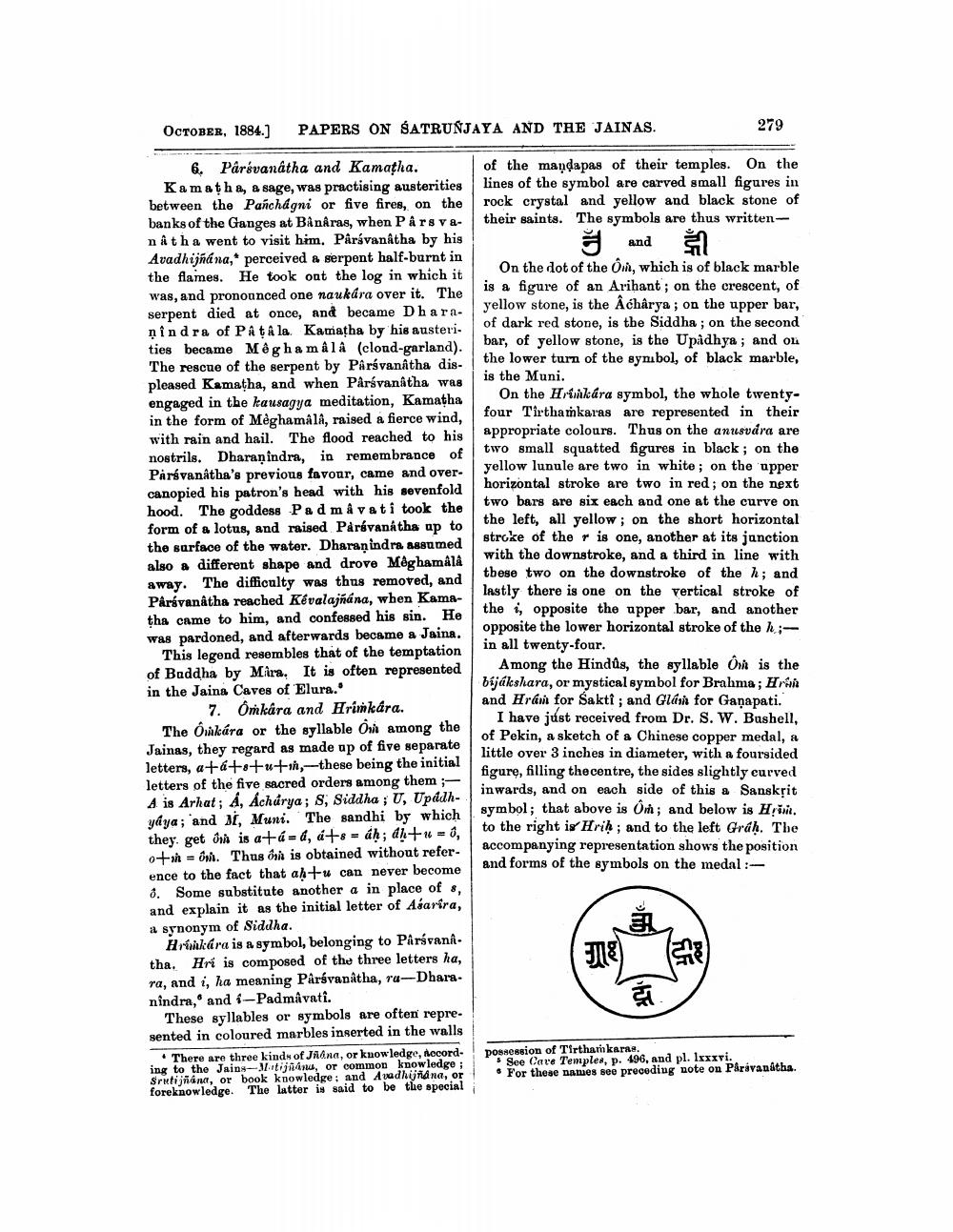________________
OCTOBER, 1884.]
PAPERS ON SATRUNJAYA AND THE JAINAS.
279
Š
and
6. Parsvanatha and Kamatha. of the mandapas of their temples. On the Kamatha, a sage, was practising austerities lines of the symbol are carved small figures in between the Panchagni or five fires, on the rock crystal and yellow and black stone of banks of the Ganges at Banâras, when Parsva- their saints. The symbols are thus writtennáth a went to visit him. Párávanatha by his Avadhijñána, perceived a serpent half-burnt in the flames. He took out the log in which it
On the dot of the on, which is of black marble was, and pronounced one naukára over it. The
is a figure of an Arihant; on the crescent, of serpent died at once, and became Dhara.
yellow stone, is the Acharya ; on the upper bar, nindra of PAt Ala Kamatha by his austeri.
of dark red stone, is the Siddha; on the second ties became Még ha mâlâ (cloud-garland).
bar, of yellow stone, is the Upadhya; and on The rescue of the serpent by Parávanátha dis
the lower turn of the synıbol, of black marble, pleased Kamatha, and when Pårsvanátha was
is the Muni. engaged in the kausagya meditation, Kamatha
On the Hrnkára symbol, the whole twentyin the form of Meghamala, raised a fierce wind,
four Tirthamkaras are represented in their with rain and hail. The flood reached to his
appropriate colours. Thus on the anusvdra are nostrils. Dharanindra, in remembrance of
two small squatted figures in black; on the Parsvanatha's previous favour, came and over
yellow lunule are two in white; on the upper canopied his patron's head with his sevenfold
horizontal stroke are two in red; on the next hood. The goddess Padmavati took the
two bars are six each and one at the curve on form of a lotus, and raised Parsvanátha up to
the left, all yellow; on the short horizontal the surface of the water. Dharanindra assumed
stroke of the ris one, another at its junction also a different shape and drove Meghamala
with the downstroke, and a third in line with away. The difficulty was thus removed, and
these two on the downstroke of the h; and Pårsvanatha reached Kévalajñána, when Kama
lastly there is one on the vertical stroke of tha came to him, and confessed his sin. He
the i, opposite the upper bar, and another was pardoned, and afterwards became a Jaina.
opposite the lower horizontal stroke of the R;
in all twenty-four. This legend resembles that of the temptation of Buddha by Mira. It is often represented Among the Hindús, the syllable On is the in the Jaina Caves of Elura.
bijákshara, or mystical symbol for Brahma ; Hrin 7. Omkara and Hrimkâra.
and Hrain for Saktî; and Glash for Ganapati.
I have just received from Dr. S. W. Bushell, The Onkára or the syllable Oi among the
of Pekin, a sketch of a Chinese copper medal, a Jainas, they regard as made up of five separate
little over 3 inches in diameter, with a foursided letters, a+&+stutin,-these being the initial
figure, filling thecentre, the sides slightly curved letters of the five sacred orders among them ;
inwards, and on each side of this a Sansksit A is Arhat; A, Achúrya; S, Siddha; U, Upadh
symbol; that above is On; and below is Hri. yaya; and ai, Muni. The sandhi by which
to the right is Hrih; and to the left Grah. The they get or is atá = á, áts = áh; dh+u = 0, oton = on. Thus on is obtained without refer
accompanying representation shows the position ence to the fact that ah+u can never become
and forms of the symbols on the medal:8. Some substitute another a in place of , and explain it as the initial letter of Asarira, a synonym of Siddha.
Hránkára is a symbol, belonging to Parávanitha. Hri is composed of the three letters ha, ra, and i, ha meaning Parávanátha, ru-Dharanîndra, and iPadmavati.
These syllables or symbols are often represented in coloured marbles inserted in the walls
There are three kinds of Jnana, or knowledge, accord- possession of Tirtharikarte. ing to the Jains- tijndnu, or common knowledge See Cave Temples, p. 496, and pl. lxxxvi. Sruti jnance, or book knowledge and Avadhifana, or . For these names see preceding note on Párávanatha. foreknowledge. The latter is said to be the speciali




